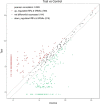The potential of tRF-21-U0EZY9X1B plasmatic level as a biomarker of children with obstructive sleep apnea-hypopnea syndrome
- PMID: 37101156
- PMCID: PMC10134554
- DOI: 10.1186/s12887-023-04020-2
The potential of tRF-21-U0EZY9X1B plasmatic level as a biomarker of children with obstructive sleep apnea-hypopnea syndrome
Abstract
Purpose: We investigated changes in plasma transfer RNA related fragments (tRF) in children with obstructive sleep apnea-hypopnea syndrome (OSAHS) and the potential value as a disease marker.
Methods: Firstly, we randomly selected five plasma samples from the case group and the control group for high-throughput RNA sequencing. Secondly, we screened one tRF with different expression between the two groups, amplified it by quantitative reverse transcription-PCR (qRT-PCR) and sequenced the amplified product. After confirming that the qRT-PCR results were consistent with the sequencing results and the sequence of the amplified product contained the original sequence of the tRF, we performed qRT-PCR on all samples. Then we analyzed the diagnostic value of the tRF and its correlation with some clinical data.
Results: A total of 50 OSAHS children and 38 control children were included in this study. There were significant differences in height, serum creatinine (SCR) and total cholesterol (TC) between the two groups. The plasma expression levels of tRF-21-U0EZY9X1B (tRF-21) were significantly different between the two groups. Receiver operating characteristic curve (ROC) showed that it had valuable diagnostic index, with area under the curve (AUC) of 0.773, 86.71% and 63.16% sensitivity and specificity.
Conclusions: The expression levels of tRF-21 in the plasma of OSAHS children decreased significantly which were closely related to hemoglobin, mean corpuscular hemoglobin, triglyceride and creatine kinase-MB, may become novel biomarkers for the diagnosis of pediatric OSAHS.
Keywords: Biomarker; Children; Obstructive sleep apnea-hypopnea syndrome; tRNA-derived fragments.
© 2023. The Author(s).
Conflict of interest statement
The authors have no relevant financial or non-financial interests to disclose.
Figures





Similar articles
-
Plasma tRF-16-79MP9PD and tRF-28-OB1690PQR304 as potential biomarkers for 4- to 7-year-old children with obstructive sleep apnea-hypopnea syndrome.Front Pediatr. 2023 May 30;11:1141348. doi: 10.3389/fped.2023.1141348. eCollection 2023. Front Pediatr. 2023. PMID: 37325347 Free PMC article.
-
Plasma expression of HIF-1α as novel biomarker for the diagnosis of obstructive sleep apnea-hypopnea syndrome.J Clin Lab Anal. 2020 Dec;34(12):e23545. doi: 10.1002/jcla.23545. Epub 2020 Sep 8. J Clin Lab Anal. 2020. PMID: 32896931 Free PMC article.
-
Gut microbiota dysbiosis in 4- to 6-year-old children with obstructive sleep apnea-hypopnea syndrome.Pediatr Pulmonol. 2022 Sep;57(9):2012-2022. doi: 10.1002/ppul.25967. Epub 2022 Jun 2. Pediatr Pulmonol. 2022. PMID: 35580999
-
Advances in non-coding RNA as a biomarker for obstructive sleep apnoea hypoventilation syndrome.Sleep Breath. 2024 Oct;28(5):1899-1908. doi: 10.1007/s11325-024-03109-x. Epub 2024 Jul 17. Sleep Breath. 2024. PMID: 39017902 Review.
-
The correlation of serum/plasma IGF-1 concentrations with obstructive sleep apnea hypopnea syndrome: A meta-analysis and meta-regression.Front Endocrinol (Lausanne). 2022 Aug 31;13:922229. doi: 10.3389/fendo.2022.922229. eCollection 2022. Front Endocrinol (Lausanne). 2022. PMID: 36120463 Free PMC article.
Cited by
-
Diagnostic potential of biomarkers in the assessment of pediatric obstructive sleep apnea-A systematic review and meta- analysis.Eur Arch Otorhinolaryngol. 2025 May 1. doi: 10.1007/s00405-025-09424-7. Online ahead of print. Eur Arch Otorhinolaryngol. 2025. PMID: 40310520 Review.
References
-
- DelRosso LM, Epidemiology, Diagnosis of Pediatric Obstructive Sleep Apnea. Curr Probl Pediatr Adolesc Health Care. 2016 Jan;46(1):2–6. 10.1016/j.cppeds.2015.10.009. - PubMed
-
- Hodges E, Marcus CL, Kim JY et al. Depressive symptomatology in school-aged children with obstructive sleep apnea syndrome: incidence, demographic factors, and changes following a randomized controlled trial of adenotonsillectomy. Sleep. 2018 Dec 1;41(12):zsy180. doi: 10.1093/sleep/zsy180. - PMC - PubMed
-
- Khayat R, Pleister A. Consequences of obstructive sleep apnea: Cardiovascular Risk of Obstructive Sleep Apnea and whether continuous positive Airway pressure reduces that risk. Sleep Med Clin. 2016 Sep;11(3):273–86. 10.1016/j.jsmc.2016.05.002. - PubMed
-
- Davies CR, Harrington JJ. Impact of obstructive sleep apnea on neurocognitive function and impact of continuous positive air pressure. Sleep Med Clin. 2016 Sep;11(3):287–98. 10.1016/j.jsmc.2016.04.006. - PubMed
Publication types
MeSH terms
Substances
LinkOut - more resources
Full Text Sources
Miscellaneous

